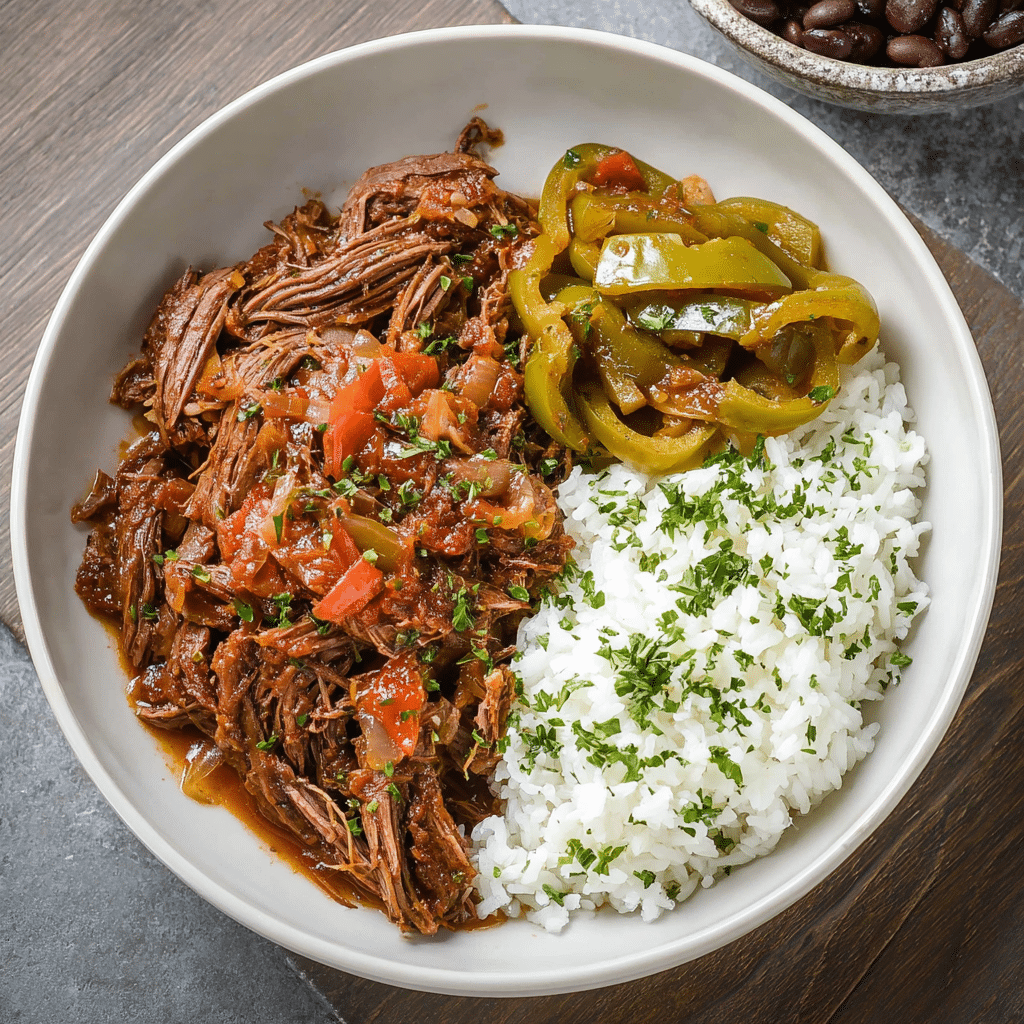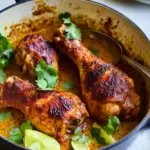The savory, aromatic dish known as Ropa Vieja is Cuba’s national treasure—literally translating to “old clothes,” due to the shredded beef’s resemblance to torn cloth. Flank steak is slow-braised in a tomato-wine broth with sweet peppers, onions, garlic, and bold spices until melt-in-your-mouth tender. It’s rich in both flavor and heritage, often enjoyed with rice, beans, or fried plantains.
Ropa Vieja is more than just a recipe—it’s a cultural expression. Its roots trace back to Spain’s Canary Islands and it remains a staple across Latin America, particularly in Cuban households. This comforting dish delivers warmth, nostalgia, and a deeply satisfying balance of tang, spice, and umami in every bite.
Full Recipe
Ingredients:
-
2½ lbs flank steak
-
2 tablespoons olive oil
-
1 large onion, sliced
-
1 large green bell pepper, sliced
-
1 large red bell pepper, sliced
-
4 garlic cloves, minced
-
1 teaspoon dried oregano
-
½ teaspoon ground cumin
-
¼ teaspoon crushed red pepper flakes (optional)
-
1 bay leaf
-
1 cup dry white wine
-
1 (8 oz) can tomato sauce
-
1 (14.5 oz) can diced tomatoes
-
1 cup beef broth
-
Salt and black pepper to taste
-
Chopped parsley or cilantro, for garnish
Directions:
-
Season flank steak with salt and pepper. In a large pot, heat 1 tablespoon olive oil over medium heat. Sear the steak on both sides until browned, about 4–5 minutes per side. Remove steak and set aside.
-
In the same pot, add the remaining olive oil. Sauté onions and bell peppers until soft and fragrant, about 5–6 minutes.
-
Stir in garlic, oregano, cumin, and red pepper flakes. Cook for 1 minute.
-
Add tomato sauce, diced tomatoes, wine, beef broth, and bay leaf. Stir to combine.
-
Return the steak to the pot. Bring to a simmer, then cover and cook on low for 2½ to 3 hours until beef is fork-tender.
-
Once cooked, remove the steak and shred with two forks. Return the shredded beef to the pot and stir. Simmer uncovered for an additional 10–15 minutes to allow the sauce to thicken.
-
Taste and adjust seasoning. Remove bay leaf. Garnish with fresh parsley or cilantro. Serve with rice, black beans, or fried plantains.
Prep Time: 20 minutes | Cooking Time: 3 hours | Total Time: 3 hours 20 minutes
Kcal: 368 kcal | Servings: 6 servings
Exploring the Richness of Cuban Ropa Vieja
Cuban Ropa Vieja is not just a dish—it is a culinary symbol that carries with it centuries of tradition, storytelling, and cultural expression. Often considered the national dish of Cuba, Ropa Vieja has a legacy that stretches beyond borders and blends flavors that speak of both hardship and celebration. Its very name, which means “old clothes” in Spanish, is derived from the dish’s appearance: tender strands of shredded beef that resemble tattered rags, swimming in a hearty tomato-based sauce. But don’t let the name fool you—this dish is anything but ordinary. It is a comforting, soulful stew filled with complex layers of flavor and history.
The Origins and History of Ropa Vieja
Ropa Vieja traces its roots back to the Canary Islands, a Spanish archipelago off the coast of northwestern Africa. From there, Spanish settlers brought the recipe to Cuba during the colonial era. The original version was typically made with leftover meat and vegetables, making it a practical way to use every part of a meal. Over time, the Cuban version evolved, incorporating local ingredients and bold Caribbean seasonings that distinguish it from its Spanish ancestor.
This transformation turned Ropa Vieja into more than just sustenance—it became a dish steeped in family tradition, often cooked slowly and served during large gatherings. In Cuban households, Ropa Vieja is a source of nostalgia, a dish that is passed down through generations and lovingly prepared during holidays or special occasions.
Culinary Profile and Key Characteristics
At the heart of Ropa Vieja lies a rich tomato-based sauce infused with aromatic spices such as cumin, oregano, garlic, and bay leaves. The beef, typically flank steak, is slow-cooked until it is fork-tender, then shredded and simmered back into the sauce to absorb all the deep, savory flavors. Bell peppers and onions add sweetness and texture, while white wine and broth enrich the sauce with depth and body.
The resulting dish is intensely flavorful—savory with a subtle sweetness from the peppers, acidic from the tomatoes, and balanced with the earthiness of the beef. Each bite offers a soft, melt-in-your-mouth texture with bursts of complexity, making it an unforgettable experience for the palate.
Why Ropa Vieja is a Staple in Cuban Cuisine
There are many reasons why Ropa Vieja is cherished in Cuban culinary culture. It is a versatile dish that fits both humble weekday dinners and grand celebratory feasts. Its slow-cooked nature reflects the patience and care found in traditional Cuban cooking. It also speaks to the ingenuity of using minimal resources to create something rich and nourishing.
Ropa Vieja is traditionally served with white rice, black beans, and fried sweet plantains—each side dish complementing the richness of the stew. The rice soaks up the vibrant sauce, the beans provide creaminess and earthiness, and the sweet plantains balance the savory notes with their caramelized edges. This combination of elements makes for a well-rounded and satisfying meal.
Modern Twists and Variations
Although the classic version of Ropa Vieja remains widely beloved, modern cooks have found ways to adapt the dish to fit different dietary needs and culinary styles. For example, some recipes substitute flank steak with brisket, chuck roast, or even pork for a slightly different flavor profile. Others include olives and capers for a briny touch, or additional spices like paprika or chili powder for a spicier edge.
Vegetarian and vegan versions of Ropa Vieja are also growing in popularity, replacing the beef with jackfruit, mushrooms, or soy-based proteins that mimic the texture of shredded meat. These adaptations retain the essence of the dish while catering to a broader audience, making Ropa Vieja accessible to more people than ever before.
The Role of Ropa Vieja in Celebrations
In Cuban households, Ropa Vieja is not just food—it is a tradition. It is commonly featured during major holidays like Nochebuena (Christmas Eve), New Year’s Eve, or family reunions. Preparing it becomes a labor of love, often taking hours to slow-cook the beef until it is tender enough to shred. This process is more than cooking; it’s an act of sharing, of bringing people together around a table filled with the aromas of simmering tomatoes, garlic, and spices.
During such occasions, it is common to pair Ropa Vieja with festive drinks like mojitos or Cuban coffee, further enhancing the celebratory mood. Music, laughter, and storytelling often accompany the meal, reinforcing the idea that food is central to Cuban culture and identity.
Pairing Ideas for a Complete Experience
To elevate your Ropa Vieja meal, consider pairing it with complementary side dishes and beverages. Besides the traditional rice, beans, and plantains, it also goes well with:
-
Yuca con Mojo: A starchy root vegetable dressed with a garlicky citrus sauce.
-
Tostones: Twice-fried green plantains that offer a crunchy contrast.
-
Cuban Bread: Soft on the inside and crusty on the outside, perfect for sopping up the sauce.
For drinks, light-bodied wines like Tempranillo or Albariño can complement the acidity of the tomato sauce, while a cold beer or Cuba Libre (rum and cola with lime) keeps things casual and refreshing.
Tips for Cooking Ropa Vieja at Home
To master Ropa Vieja at home, a few techniques can make all the difference. Always brown the meat before braising—it develops flavor through the Maillard reaction and gives the final stew a deeper, meatier taste. Use fresh spices and herbs when possible, and don’t rush the simmering process. The key to tender beef and a well-rounded sauce is patience.
Leftovers store beautifully and taste even better the next day as the flavors continue to meld. It also freezes well, making it an excellent meal-prep option for busy weeknights.
A Dish That Connects People Across Cultures
Although it originated in Cuba, Ropa Vieja has found a home in many Latin American countries and beyond. Its ability to comfort, nourish, and connect people has made it a beloved staple in homes around the world. Whether you’re discovering it for the first time or returning to a dish you grew up with, Ropa Vieja serves as a reminder of how food can bridge cultures and generations.
In places like Puerto Rico, the Dominican Republic, and even parts of the United States with large Cuban populations, this dish is a restaurant favorite and a must-try for anyone wanting to experience the soul of Cuban cuisine.
Conclusion
Ropa Vieja is more than just a slow-cooked beef stew—it’s a culinary narrative that weaves together history, culture, and community. It tells the story of resilience and creativity, of humble beginnings turned into culinary masterpieces. Rich in flavor and heritage, this dish captures the spirit of Cuban cuisine in every forkful.
From its Spanish roots to its Caribbean evolution, Ropa Vieja embodies the warmth and heart of home cooking. Whether served on a busy weekday or during a joyous family gathering, it offers both sustenance and a deep sense of belonging. For anyone seeking a dish that is as comforting as it is flavorful, Cuban Ropa Vieja is a timeless classic worth savoring.






